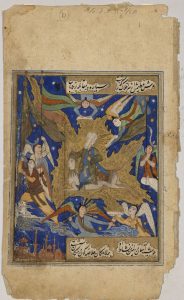Night Journey of the
Prophet Muhammad (Mi’raj)
Ink, opaque watercolors, and gold pigment on paper
Gift of Elinor Lander Horwitz, Class of 1950
SC 2016: 29-9
In this manuscript page, the Prophet Muhammad, surrounded by a golden radiance symbolizing the light of Islam, is carried through the air by Al-Burāq (lightning) a mythological white steed, brought to Muhammad by the Angel Jibril (Gabriel).
Burāq is described variously, according to different versions of Hadith (reports of traditions and sayings of the Prophet). Sometimes Burāq is masculine, other times feminine or androgynous, and made up of various animals. Here, we see Burāq with the body of a horse, a lion tail, and an androgynous human face.
The visage of Muhammad has been effaced, leaving a white smear as a “veil.” The faces of the surrounding angels and Burāq are untouched. Due to varying interpretations of Islam’s prohibitions on images of living beings, oftentimes subsequent owners of these manuscripts removed the eyes or faces of certain figures. The fact that someone acquired the book yet erased the face exposes the complex nature of image prohibition in Islam.
Nicole Bearden, Smith College AC ‘19
The Night Journey of the Prophet Muhammad (Mi’raj)
[Detailed Image Description: On a small, portrait-oriented rectangle with a bright blue background, are nine figures. The largest two figures are the Prophet Muhammad and Buraq. Buraq is portrayed here as a white, horse-like being with a human face and a lion tail, and Muhammad is shown as a man wearing a long, blue garment, and brown robe, with his face and turban smudged together as a white smeared “veil”, riding the horse-being. These are located in the center of the image. They are enveloped in an aureola of gold, resembling flames. Around the central figures, surrounding the edges of the work on all sides, are seven figures with human forms [angels] and pointed wings, holding banners, with their attention turned to the central figures. The top center figure seems to be dropping from the sky, their head oriented down above the central figures. This figure, wearing a light blue garment, with a green and dark orange flowing scarf, holds a small white scroll in their hands. The next figure, to the left, and slightly below the middle angel, is clothes in a light green tunic, light blue loose pants, and a dark orange scarf, is also presenting a small, white scroll to the central figure. The next angel figure, is below, on the right-center edge of the page, has clasped hands and wears an orange tunic, with a dark blue scarf, and white, loose pants. Below, this figure, in the bottom, right corner, is an angel clad in a light orange/gold tunic, presenting a platter of gold fire/light, which resembles the aureola surrounding the central figures. To the left of this figure, in the bottom center of the page, is the figure of the Islamic archangel Israfil, in a light blue tunic, holding a large, gold trumpet. To the left, and above Israfil, in the left center of the page, are the last two angelic figures. The bottom-most figure wears light gold loose pants, and a short-sleeved brown tunic, over a long sleeved gold shirt. This one holds up a banner and is looking to the central figures. The final figure, just above the former, wears a white tunic and is also holding up a banner, looking to the central figures of Muhammad and Buraq. There are wispy, light gray clouds dispersed throughout, along with miniature stars and planets, and a long, brown figure of a lion, symbolising Imam Ali, within the golden aureola in the top left corner, hovering above the central figures. Two rectangular couplets, one in the top right corner, and one in the bottom right corner contain Persian calligraphic script. Very small, in the bottom left corner, is the brown outline of a domed mosque with minarets. A very faint, finely rendered outline border of gold and dark blue lines surrounds the image. The page is faded in many parts, and the edge is irregular as if torn from a book.]
